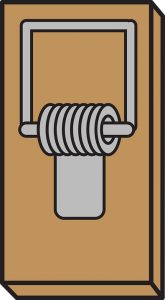
Springs have been around for centuries. In the 15 century, they were used to create door locks as well as mechanical clocks. Over the years, however, springs have evolved into a variety of different types, one of which is torsion. Torsion springs are able to store energy — just like all springs — but they feature a unique design that distinguishes them from other types of springs.
What Is a Torsion Spring?
A torsion spring is a type of spring that requires a twisting action to store mechanical energy. When exposed to a load, torsion springs will twist while subsequently storing mechanical energy from the load. They’ll also create torque in the opposite direction to that in which they were twisted.
Most mouse traps feature a torsion spring. The torsion spring in mouse straps is used to “set” them so that they snap down when exposed to a load. Known as a helical torsion spring, it consists of a coiled piece of metal and a rod. Pressing the rod down will twist the coiled piece of metal so that it’s able to store mechanical energy.
In addition to mouse straps, other applications for torsion springs include clothespins, clocks, garage door openers, automotive trunk latches and sway bars.
Most torsion springs are made of stainless steel. Stainless steel is strong and durable. It’s also resistant to corrosion, thus prolonging the life of the torsion springs with which it’s used. You can find torsion springs made of other types of metals and alloys, but stainless steel is the most common. Stainless steel torsion springs are popular because of their strength, durability and longevity.
Torsion vs Extension Spring: What’s the Difference?
Torsion springs aren’t the same as extension springs. Extension springs are designed specifically to operate under a tension load. You can connect an extension spring between two parts. As the two parts attempt to pull away from each other, the extension spring will become longer.
Unlike extension springs, torsion springs don’t become longer when exposed to a load. They simply twist when exposed to a load. Torsion springs will twist along their axis when exposed to a load. After being twisted, they’ll store mechanical energy from the load.
Other Types of Springs
Torsion and extension are two of many common types of springs. Another common type of spring is compression. Compression springs are essentially the opposite of extension. Extension springs become longer when exposed to a load, whereas compression springs become shorter.
